Top 30 Backyard Birds
Part I Part II Part III Part IV Part V Part VI
|
|
This penultimate chapter includes five birds that fall under the rough designation of Ground-feeding Birds. While not an official category of evolutionary biology, this grouping has some practical implications for the backyard birdfeeder. While all of these birds readily enjoy seeds such as millet and sunflower, they range between uncomfortable and utterly incapable in their relationships with typical hanging tube feeders fitted with narrow perches. In nature, they search for seeds and insects on the ground, and they will often do the same underneath your feeders, acting as a natural clean-up crew that chases down each wayward seed that falls. If you would like to feed them more directly, attach a tray to the bottom of your tube feeder, or add a separate platform or tray type feeder that will allow these birds to feed comfortably.
21. White-crowned Sparrow
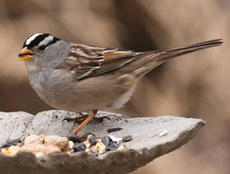 Identifying: Adults are easy, with their namesake black and white crowns. Immature birds require a little more attention, with relatively nondescript, brown and tan striped heads. Note their overall large sparrow size and shape which matches the adults, as well as their generally orangish bill color. The most common bird of similar size and habits is the Golden-crowned Sparrow—see below to avoid confusion.
Identifying: Adults are easy, with their namesake black and white crowns. Immature birds require a little more attention, with relatively nondescript, brown and tan striped heads. Note their overall large sparrow size and shape which matches the adults, as well as their generally orangish bill color. The most common bird of similar size and habits is the Golden-crowned Sparrow—see below to avoid confusion.
Notes: White-crowned Sparrows are one of our most abundant and widespread yard birds from October until March. Our main winter population then heads to summer nesting sites in the Northwest, Canada, and Alaska, although we do have a solid year-round presence along the immediate coast and another subspecies you can visit on a summer trip to the Sierras. Like most of their sparrow brethren, they readily eat seeds including millet and sunflower, as well as suet (if they can reach it). While you will probably attract some sparrows by default as search for fallen seeds underneath your feeder, you can make your feeding station more sparrow-friendly by adding a tray to your tube feeders or by using a stand-alone or hang-alone tray feeder, that replaces narrow perches with a more comfortable, wide feeding platform.
22. Golden-crowned Sparrow
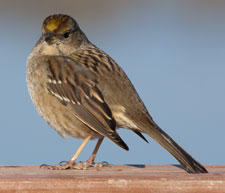 Identifying: Another bird with a helpful name! That often doesn’t happen! But it’s true, even if the golden crowns rather lose their luster in winter compared to the bright yellow they sport in summer (not spent here). Still, dull though it is, it is generally recognizably golden enough to identify them without trouble: if it has a golden crown, it’s a Golden-crown. You can also note that they have dull gray bills, in contrast with the orange bills of the White-crowns.
Identifying: Another bird with a helpful name! That often doesn’t happen! But it’s true, even if the golden crowns rather lose their luster in winter compared to the bright yellow they sport in summer (not spent here). Still, dull though it is, it is generally recognizably golden enough to identify them without trouble: if it has a golden crown, it’s a Golden-crown. You can also note that they have dull gray bills, in contrast with the orange bills of the White-crowns.
Notes: Golden-crowns are similarly abundant in winter, descending from their far northern breeding grounds to spend a good chunk of their year in our more hospitable latitudes. White-crowns and Golden-crowns make up the great mass of our winter sparrows seen around backyard feeders, but you can also see our Winter Sparrows page for tips on the two less common members of the club, the Fox Sparrow and the White-throated Sparrow. Golden-crowned Sparrows are our most notable singer of fall, performing their song of three clear, whistled, descending notes frequently after their arrival in September and October, occasionally through the winter, and then more frequently again before their departure around April.
23. Spotted Towhee
Identifying: You may remember our earlier coverage of the California Towhee in Chapter 1. The Spotted Towhee is their somewhat more glamorous cousin, but shares the same basic towhee shape (big sparrow with longish tail). Unlike the dull brown of the Cal Towhee, the Spotted Towhee is vividly colored with a dark head and back, red-brown (rufous) sides, and a white belly. Some beginners mistake them for juncos in their field guides—Spotted Towhees are distinctly bigger than sparrows, finches, et alios; have black wings flecked with white; and have dark bills.
 Local picture by Laura Milholland |
Notes: Field guides of a certain age may refer to this bird as the Rufous-sided Towhee, a moniker it formerly shared with the similar Eastern Towhee from whom it has now been taxonomically ripped asunder. Spotted Towhees are less abundant in yards than California Towhees and not everyone will see them around their home: they require a fairly dense understory, where they can scratch noisily in the leaf litter with some illusions of privacy. If you don’t have them in your yard, you can easily visit them in a range of natural communities including chaparral, coastal scrub, brushy woodlands, riparian thickets and wherever those two requirements of dense brush and rich leaf litter are found.
24. Mourning Dove
|
Local picture by Risa George |
Identifying: Most people recognize the basic dove/pigeon shape. Mourning Doves are our most common dove of residential areas and are relatively small (compared to city pigeons) and light gray-brown with black spots. If you want to review our full dove and pigeon lineup, feel free to peruse our Doves and Pigeons Birds of the Month profile, replete with fine local photos and eloquent selections from the rich dove-based literature.
Notes: Mourning Doves’ name refers to their biggest claim to fame, their mournful cooing along the lines of coo-AHH, coo, coo, coo. As with birdsong generally, spring is the time to hear it. As with other doves and pigeons, they can do particularly good clean-up under feeders due to their habit of swallowing whole seeds, including shells. Not equipped with seed-cracking beaks, Mourning Doves rely on their powerful gizzards to break down hard shells, greatly simplifying the job of ingesting tiny shelled Nyjer seed, for example.
25. California Quail
Identifying: Unmistakable. They look like this:
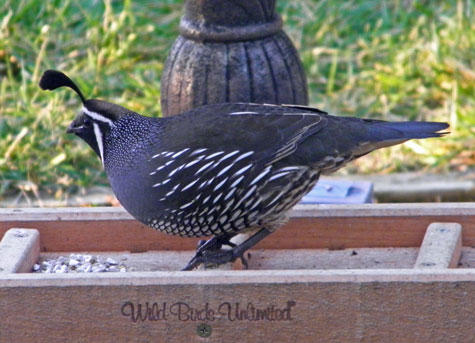 Notes: The State Bird of California, chosen back when their value as a game bird was probably their primary attraction to the state bird naming committee, but now well-established in the hearts of those who like to just watch them. They are generally charming and charismatic, with their loud, distinctive chi-ca-go calls, highly visible family life (the only bird so far featured which has precocial young who start running around soon after being born rather than spending several days as a helpless nestling), and great enthusiasm for any seed offerings you choose to give them.
Notes: The State Bird of California, chosen back when their value as a game bird was probably their primary attraction to the state bird naming committee, but now well-established in the hearts of those who like to just watch them. They are generally charming and charismatic, with their loud, distinctive chi-ca-go calls, highly visible family life (the only bird so far featured which has precocial young who start running around soon after being born rather than spending several days as a helpless nestling), and great enthusiasm for any seed offerings you choose to give them.
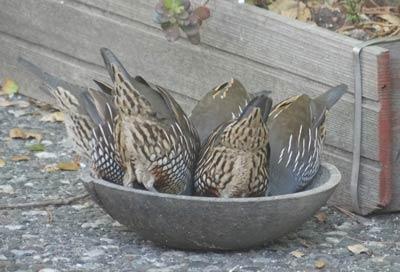 Quail are absent from many yards; falling very firmly into the “ground-feeding” camp and capable of only short flights, they have less flexibility than many suburban birds in using patches of useful habitat among our neighborhoods. Instead, they need relatively larger and more continuous areas of habitat rich in shrubby cover to provide protection from predators such as Cooper’s Hawks and house cats. If you are fortunate enough to host quail around your home, they will come readily to millet, cracked corn, sunflower, and water placed in low accessible locations.
Quail are absent from many yards; falling very firmly into the “ground-feeding” camp and capable of only short flights, they have less flexibility than many suburban birds in using patches of useful habitat among our neighborhoods. Instead, they need relatively larger and more continuous areas of habitat rich in shrubby cover to provide protection from predators such as Cooper’s Hawks and house cats. If you are fortunate enough to host quail around your home, they will come readily to millet, cracked corn, sunflower, and water placed in low accessible locations.
Quail at millet bowl, local photo by Eileen Prendiville. Click for full size.
Featured Product: Celestron Nature DX 8x32
Take a look at our Binoculars Page to learn more about birdwatching optics, or just take a look at a few pairs on your next visit to the store. |


 Attaching a tray to your tube feeder reduces spillage and makes your feeder more friendly to sparrows and other ground-feeding birds
Attaching a tray to your tube feeder reduces spillage and makes your feeder more friendly to sparrows and other ground-feeding birds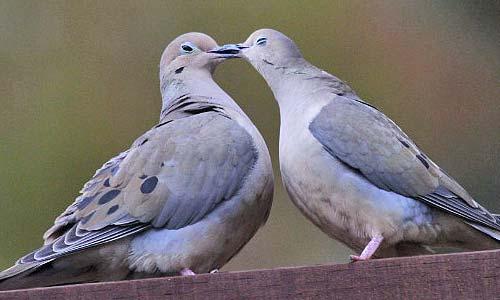
 The one essential tool for watching birds is a pair of binoculars. If you don't have a decent pair, we recommend investing at least $100 if at all possible and getting something you can actually see through. Our current top pick in the world of affordable optics is the Celestron Nature DX 8x32 ("8x32" indicates a lighter-weight, mid-sized binocular compared to a standard full size "8x42"). Of course, you can always spend more for a brighter, sharper image, lifetime warranties, and other worthwhile features. But for excellent optics and a moderate price tag, this is a great place to start.
The one essential tool for watching birds is a pair of binoculars. If you don't have a decent pair, we recommend investing at least $100 if at all possible and getting something you can actually see through. Our current top pick in the world of affordable optics is the Celestron Nature DX 8x32 ("8x32" indicates a lighter-weight, mid-sized binocular compared to a standard full size "8x42"). Of course, you can always spend more for a brighter, sharper image, lifetime warranties, and other worthwhile features. But for excellent optics and a moderate price tag, this is a great place to start.